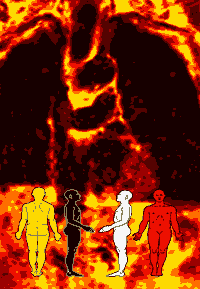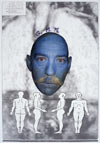 |
The projects "Add and Pass" or "Add, Alter and Return" are in the root of mail art. One of the creators of the movement of mail art in the mid sixties, the FLUXUS artist (from New York), Ray Johnson, used to send unfinished paper sheets with drawings and graphic works to his friends. He asked them to complete those paper sheets and then send them to "this or that" Gallery, where they would be exhibited on a certain date.
Johnson was not only creating a new gender of mail art, like postcards or artist-stamps (creative and apocryphal post stamps), but he was also setting the basis of a new form of enjoying and creating arts: the interactivity. It is the possibility of sharing with others the magic and the miracle of inventing, or "taking out of the gallery" a new object, an opus, a real creation with expression capacity, born of nothing.
Of course, the sublime image of the creator diminished, and the own project (or womb) could be seen substantially altered until it might not be recognized even by the own author.
This new “shared functionality” was in the core of the art motives
of the sixties. The selfish image of the artist “unique and superb”
was intended to be rubbed out by all means, for the benefit of the people who,
until that moment, had to passively “suffer” the arbitrariness of
the artist.
“To return arts to the people” was one of the beloved statements
of the French May, 1968.
Precisely, the questioning of consumption of art (and other mechanisms) was
in the centre of the discussions of the sixties, which originated infinite art
trends, mainly concerning the experimental poetry: Poem/Process, Poem of Action,
Inobjectal Poem, Poetry for Performing, Poetry Two Points, Poetry for Building,
etc.
In an artistic level, FLUXUS and certain trends of Conceptualism were in charge
to carry out the programme of the real democratization of arts through the creative
participation (or interaction) of the spectator, who had been a passive and
neutral entity in front of the work until that moment. At present time (beginning
of the III Millenium), this trend regained actuality again when “Multimedia”
started, thanks to the technological advances in the area of the graphic art
of the computer industry. “Multimedia” is a kind of a virtual performance,
where a diversity of languages are applied to only one artistic entity. The
verb, the sound, the visualization, the animation, the hipertexts, that means,
almost all the expressive media that build the so-called “way of expression”
are put together in an “opus” whose significance is of a very diverse
nature.
The clue, the interface that makes possible the reception of the message, is
exactly the interaction which was generated in the sixties, encouraged by mail
art.
Nevertheless, we must point out that the interaction, which the digital art
makes possible, is limited, since all possible variations (although a lot) are
not infinite. So the moment comes, when the spectator decodes all of them, exhausting
the information of the work.
Whereas, it does not operate like the “open work” that was suggested
by the mailings of Johnson’s “Add and Pass”, whose alteration
and change possibilities were infinite, in accordance with the size of the net
of participants in the project (the network).
The formal conquests of the Brazilian Poem/Process are not surpassed either,
in which the recreation of the poem was allowed, not only according to the level
of knowledge and personal experience of the reader, but also according to the
available materials that the place as well as the technological advances made
possible. However, these deficiencies of the forms of virtual expression will
be overcome, without any doubt, by means of the constant and frequent advances
of the software applied on the field of communications.
The visual basis of the project “OPERATION MANKIND” of the artist
Hans Braumüller, born in Santiago de Chile, is a scheme of the human body,
on which medical studies are carried out. The author has distributed it to his
fellow artists, in order that they alter the scheme according to the rules of
ADD and PASS, and then send it back to him for an exhibition in the Arts Hall
of the Corporation of Hospitals.
Certainly, the interpretations are made by each person, but Braumüller’s
message is clear to us. Mankind like a patient, who analyzes, and diagnoses
by himself as “ill”, and prescribes himself the means for his healing
through the analysis of his existence by unfolding interaction (communication
through interfaces). The physicians often prescribe a change of environment
as a way of healing. Wouldn’t it be the time to advise the whole humankind
to make a change in the socio-economic order?
Clemente Padín
February 2003, special for Hans Braumüller and his project „OPERATION
MANKIND“ (Translation from spanish by Gioconda Moreno)
|
|


